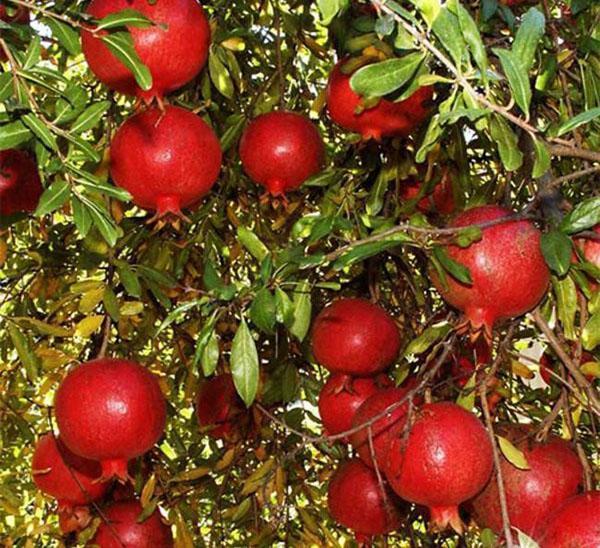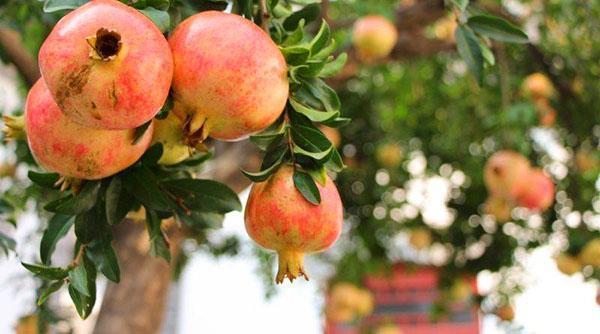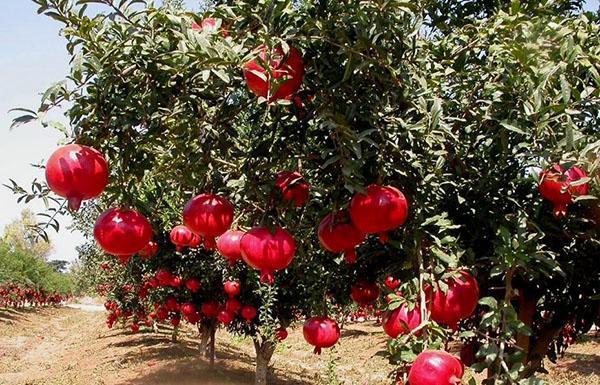How the "chest" of useful microelements grows - the incomparable royal pomegranate fruit
 Some people believe that there are no perfect creatures in the world around us. Perhaps this is so, but if we consider in detail how a pomegranate grows, it is easy to refute this theory. The majestic exotic tree possesses exquisite beauty, unrivaled fertility and valuable properties. Its bright red fruits are reminiscent of small lights that can keep you warm on harsh winter days. Looking at them, one involuntarily recalls the sultry summer in the southern regions and the charming colors of exotic resorts. Despite this, many do not think about how the stately pomegranate grows in nature and whether it can be grown at home.
Some people believe that there are no perfect creatures in the world around us. Perhaps this is so, but if we consider in detail how a pomegranate grows, it is easy to refute this theory. The majestic exotic tree possesses exquisite beauty, unrivaled fertility and valuable properties. Its bright red fruits are reminiscent of small lights that can keep you warm on harsh winter days. Looking at them, one involuntarily recalls the sultry summer in the southern regions and the charming colors of exotic resorts. Despite this, many do not think about how the stately pomegranate grows in nature and whether it can be grown at home.
Read also:how to clean a pomegranate quickly and without splashing?
A brief excursion into the distant past

 In view of these facts, it is rather difficult to say where the pomegranate tree was first discovered, because today the culture can be found in many parts of the planet. It is grown in North Africa, Italy, Spain, Azerbaijan and Turkey. The fruit is popular in the valleys of the Caucasus Mountains. He has fans in Abkhazia and sunny Georgia. There are many known places in Russia where pomegranate grows. This is the southern part of the Krasnodar Territory, the Crimean Peninsula and the Azov region. Enterprising gardeners are trying to grow new cold-resistant species in the middle latitudes and even in the Moscow region.
In view of these facts, it is rather difficult to say where the pomegranate tree was first discovered, because today the culture can be found in many parts of the planet. It is grown in North Africa, Italy, Spain, Azerbaijan and Turkey. The fruit is popular in the valleys of the Caucasus Mountains. He has fans in Abkhazia and sunny Georgia. There are many known places in Russia where pomegranate grows. This is the southern part of the Krasnodar Territory, the Crimean Peninsula and the Azov region. Enterprising gardeners are trying to grow new cold-resistant species in the middle latitudes and even in the Moscow region.
Since pomegranate is considered a valuable storehouse of useful substances, it has attracted interest even during the reign of the Egyptian pharaohs and Roman Caesars. It is interesting that during the capture of the Phoenician city of Carthage by the Romans, only pomegranate trees survived. After that, the fruit was called the "king" of exotic fruits. In addition, a stately crown of sepals stood at its top, which became the prototype of the royal crown.  The photo provided shows how a pomegranate grows on the branches of an exotic tree.
The photo provided shows how a pomegranate grows on the branches of an exotic tree.
Translated into Russian, pomegranate means "granular apple", which reminds of its beneficial properties for health. Truly, a valuable "box" of precious trace elements and vitamins.
Pomegranate in natural environment
 How pomegranate grows in its natural environment is reminiscent of its origin from southern latitudes. The tree loves open areas where there is an abundance of light and air. If it lacks these major factors, the tree may never bloom. We'll have to be content with only green foliage.
How pomegranate grows in its natural environment is reminiscent of its origin from southern latitudes. The tree loves open areas where there is an abundance of light and air. If it lacks these major factors, the tree may never bloom. We'll have to be content with only green foliage.
 Depending on the area where the pomegranate grows, the harvest time changes. It takes a long and sultry summer for the fruits to fully ripen. Moreover, winter should be short and warm. The optimal temperature range is 12 degrees Celsius.
Depending on the area where the pomegranate grows, the harvest time changes. It takes a long and sultry summer for the fruits to fully ripen. Moreover, winter should be short and warm. The optimal temperature range is 12 degrees Celsius.
You can dilute pomegranates in the following ways:
- by sowing grains;
- cut-off cuttings;
- layering;
- by grafting seedlings.
 Of course, not everyone will be able to grow a full-fledged tree this way and see how the pomegranate blooms with fragrant inflorescences. Some gardeners prefer to buy a ready-made seedling and grow it in their backyard area.
Of course, not everyone will be able to grow a full-fledged tree this way and see how the pomegranate blooms with fragrant inflorescences. Some gardeners prefer to buy a ready-made seedling and grow it in their backyard area.
It is advisable to plant a young pomegranate tree in a sunny area to provide it with enough sunlight and air.
 When the tree is planted, in the first month it is watered 2 or 3 times a week. Then, the interval is reduced to 1 time for 7 days. Depending on the method of pomegranate breeding, the expectation of fruit is extended for years. For example, if cuttings are planted, the first fruits will appear in 6 years. The cut will delight you with grenades after 7 long years. And a grown seedling will begin to bear fruit already in the 3rd year. Abundant fruiting is expected by the 8th or 10th year of the plant's life. In general, the pomegranate tree lives up to 70 years of age, although there are also centenarians.
When the tree is planted, in the first month it is watered 2 or 3 times a week. Then, the interval is reduced to 1 time for 7 days. Depending on the method of pomegranate breeding, the expectation of fruit is extended for years. For example, if cuttings are planted, the first fruits will appear in 6 years. The cut will delight you with grenades after 7 long years. And a grown seedling will begin to bear fruit already in the 3rd year. Abundant fruiting is expected by the 8th or 10th year of the plant's life. In general, the pomegranate tree lives up to 70 years of age, although there are also centenarians.
 In the metropolitan parks of France, specimens grow that bear fruit for 200 years. In Azerbaijan - more than 100 years. Some varieties bear fruit for 300 years. These facts show that if you know how to grow pomegranate, you can enjoy its unique taste and beauty for a long time. To top it off, the plant does not require any special care and takes root in any soil.
In the metropolitan parks of France, specimens grow that bear fruit for 200 years. In Azerbaijan - more than 100 years. Some varieties bear fruit for 300 years. These facts show that if you know how to grow pomegranate, you can enjoy its unique taste and beauty for a long time. To top it off, the plant does not require any special care and takes root in any soil.
The fruit belongs to a family of shrubby plants that can grow up to 6 meters in height. Therefore, when choosing a place for landing, this fact must be taken into account.
Growing fruit in a summer cottage
 Lovers of exotic plants know well how to plant a pomegranate in their garden so that it bears fruit. The main condition for growing the royal fruit is fertile soil. In the selected area, a hole is dug with a diameter and depth of 60 cm. The top layer of soil is laid on its bottom, the seedling is placed at an angle of 45 degrees, slightly compacted, buried and watered abundantly. Thanks to this slope, the plant will be easier to cover for the winter with spruce branches, cloth or soil.
Lovers of exotic plants know well how to plant a pomegranate in their garden so that it bears fruit. The main condition for growing the royal fruit is fertile soil. In the selected area, a hole is dug with a diameter and depth of 60 cm. The top layer of soil is laid on its bottom, the seedling is placed at an angle of 45 degrees, slightly compacted, buried and watered abundantly. Thanks to this slope, the plant will be easier to cover for the winter with spruce branches, cloth or soil.
In no case should manure be introduced into the hole when planting a pomegranate, mineral fertilizers or humus. It is advisable to fertilize the soil 3 months before, so that the plants will successfully take root in the country garden.
The next day after planting, preferably in the evening, water and cover the soil near the trunk again mulch from slightly rotted sawdust or leaves. Water the young trees once a week. Top dressing can be applied in late spring or early June. Plow the soil around the seedling periodically, removing weeds.
 To prepare the pomegranate for the winter period, in November, the bushes are covered with soil. But, first they are tilted to the ground and tied to stable stakes. In such "storage" the tree will calmly endure cold winter frosts. And perhaps in a year the royal fruits from the summer cottage will appear on the table.
To prepare the pomegranate for the winter period, in November, the bushes are covered with soil. But, first they are tilted to the ground and tied to stable stakes. In such "storage" the tree will calmly endure cold winter frosts. And perhaps in a year the royal fruits from the summer cottage will appear on the table.
Indoor version of an exotic plant
 Unrivaled fans of the royal fruit even know the secret of how to grow and harvest pomegranates at home. For this purpose, dwarf plant varieties are suitable, which begin to bloom in the second year after planting.
Unrivaled fans of the royal fruit even know the secret of how to grow and harvest pomegranates at home. For this purpose, dwarf plant varieties are suitable, which begin to bloom in the second year after planting.
 For the tree to successfully take root, you need a small container. It should be wide so that the surface roots of the plant develop well. The soil is suitable for a slightly acidic character. If you follow these simple rules, it is not at all difficult to grow indoor pomegranates with a maximum height of 1.5 meters. It only takes a little patience and effort.
For the tree to successfully take root, you need a small container. It should be wide so that the surface roots of the plant develop well. The soil is suitable for a slightly acidic character. If you follow these simple rules, it is not at all difficult to grow indoor pomegranates with a maximum height of 1.5 meters. It only takes a little patience and effort.
There are several ways to plant an exotic potted fruit:
- ready-made seedlings from the nursery;
- germinated material from horticultural firms;
- cuttings;
- bones.
The easiest way to grow a pomegranate tree is to purchase it from a nursery. It is much more fun for gardeners to patiently grow pomegranate from seed at home.
They start business from the selection of planting material. Only seeds from fully ripe fruit, on which there are no flaws, will work.  It is advisable to find a pomegranate from a house tree, then it is more likely to grow a fruit.
It is advisable to find a pomegranate from a house tree, then it is more likely to grow a fruit.
The ripe fruit is distinguished by a dryish skin that fits tightly to the grains.If it has a shiny character, it means that the fruit was picked unripe. These bones will not work.
 The selected pomegranate should be quickly peeled and dried within 24 hours. Before planting, the seeds are soaked in milk, water or growth stimulants. Bones are placed in the prepared loosened soil to a depth of 1 cm and covered with plastic wrap. After about 20 days, shoots appear. Now you can remove the film.
The selected pomegranate should be quickly peeled and dried within 24 hours. Before planting, the seeds are soaked in milk, water or growth stimulants. Bones are placed in the prepared loosened soil to a depth of 1 cm and covered with plastic wrap. After about 20 days, shoots appear. Now you can remove the film.
Since growing a pomegranate from a seed is quite difficult, several factors should be considered:
- the container with the plant should stand on a well-lit window;
- at first, protect from direct sunlight;
- as the topsoil dries out, water regularly with clean water;
- permissible room temperature is not lower than 12 degrees.
 When the tree grows, flowers of the original shape will appear on it. Over time, they will turn into royal fruits, inside which juicy seeds are stored. They are, of course, inferior in size to imported grenades, but the value of the product remains unchanged.
When the tree grows, flowers of the original shape will appear on it. Over time, they will turn into royal fruits, inside which juicy seeds are stored. They are, of course, inferior in size to imported grenades, but the value of the product remains unchanged.
 In order for the tree to harmoniously fit into the interior, it is advisable to correct the shape of the crown once every 6 months. Usually pruning is done in spring and autumn, removing excess shoots. The soil under the plant should always be slightly damp. In the summer, the pot is taken outside or on the balcony to speed up the growth process.
In order for the tree to harmoniously fit into the interior, it is advisable to correct the shape of the crown once every 6 months. Usually pruning is done in spring and autumn, removing excess shoots. The soil under the plant should always be slightly damp. In the summer, the pot is taken outside or on the balcony to speed up the growth process.  When cold times come, it is brought into the house where the tree hibernates.
When cold times come, it is brought into the house where the tree hibernates.
The maximum temperature for a "sleeping" plant is no higher than 15 degrees. There is no need to feed him in winter. Water sparingly as the soil dries.  With the arrival of spring, young leaves appear on the pomegranate tree. It can now be fed to stimulate growth.
With the arrival of spring, young leaves appear on the pomegranate tree. It can now be fed to stimulate growth.
Initially, it is advisable to plant pomegranates in a small pot, which corresponds to the size of the earthen coma near the roots of the seedling. The tighter the container, the more abundantly the dwarf pomegranate tree blooms.
Useful properties of the magic pomegranate "chest"
 Since ancient times, people have noticed a number of beneficial properties of the royal fruit. Its berries are filled with many vitamins, mineral salts and trace elements. The juice contains a huge amount of amino acids, tannins, glucose and sugar.
Since ancient times, people have noticed a number of beneficial properties of the royal fruit. Its berries are filled with many vitamins, mineral salts and trace elements. The juice contains a huge amount of amino acids, tannins, glucose and sugar.
 Exotic pomegranate fruits have a beneficial effect on immunity, blood vessels and blood pressure. Quench thirst, stimulate appetite and lower blood sugar. The inflorescences of the royal fruit contain an abundance of dyes, therefore they are widely used in light industry. Decoctions from the peel are drunk for intestinal disorders, as a fixative. Also used for gargling and various inflammatory processes.
Exotic pomegranate fruits have a beneficial effect on immunity, blood vessels and blood pressure. Quench thirst, stimulate appetite and lower blood sugar. The inflorescences of the royal fruit contain an abundance of dyes, therefore they are widely used in light industry. Decoctions from the peel are drunk for intestinal disorders, as a fixative. Also used for gargling and various inflammatory processes.
Truly, pomegranate is an irreplaceable fruit for the whole family. It's not too late to start growing it and get a lot of pleasant emotions.